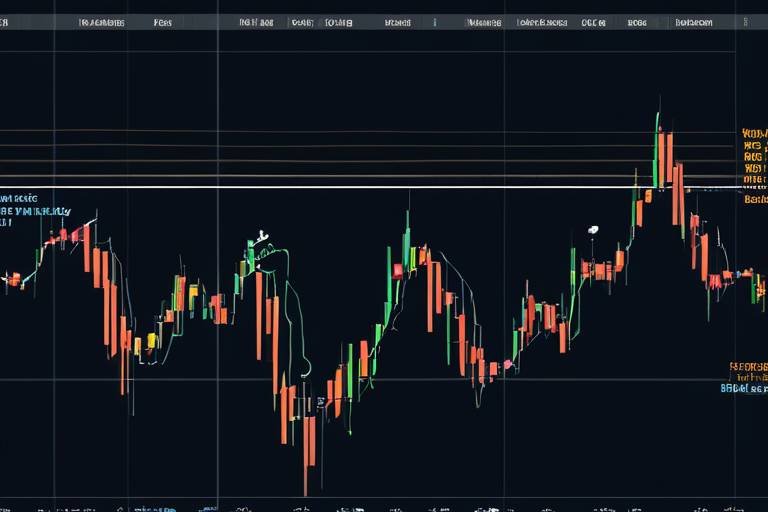How to Use Community Insights for Trading Decisions
In today's fast-paced financial markets, traders are constantly seeking an edge over their competition. One of the most powerful yet often overlooked resources is the collective knowledge and sentiment of trading communities. By tapping into these community insights, traders can enhance their strategies, improve decision-making, and ultimately achieve better outcomes. But how exactly can you leverage these insights? Let’s dive into the various aspects of using community insights effectively in your trading endeavors.
Understanding the value of community insights can significantly influence trading decisions. Imagine standing at a bustling marketplace where traders exchange not just goods, but also ideas and sentiments. This vibrant atmosphere is akin to the trading communities available today. These communities provide a wealth of information, from market trends to emotional reactions to specific stocks or cryptocurrencies. By considering the collective opinions and sentiments from various trading communities, traders can gain a broader perspective that might not be evident from traditional analysis alone.
Not all communities are created equal; identifying the right ones is crucial for effective trading. Think of it like a treasure hunt: you need to know where to look to find the gems. Start by exploring platforms such as Reddit, Discord, and Twitter, where traders frequently share insights and discuss market movements. Evaluate these communities based on their engagement levels, the expertise of the members, and the relevance of the discussions to your trading goals. Look for communities that align with your strategies, whether you're into day trading, swing trading, or long-term investments. Remember, the right community can provide invaluable support and insights.
Sentiment analysis plays a vital role in trading. It’s like having a radar that detects the emotional climate of the market. By interpreting community sentiment, traders can gauge market moods and anticipate potential price movements. For instance, if a community is overwhelmingly bullish about a particular stock, it could indicate a potential upward trend. Conversely, a surge in negative sentiment might signal a looming downturn. Understanding these trends can help traders make informed decisions, aligning their strategies with the prevailing market sentiment.
Various tools can assist in analyzing community sentiment effectively. Here are some popular platforms and technologies that traders can utilize:
- Social Media Analytics Tools: Platforms like Brandwatch and Hootsuite can help track sentiment across social media channels.
- Sentiment Analysis Software: Tools like MarketPsych and Lexalytics analyze text data from forums and social media to gauge public sentiment.
- Trading Bots: Some bots are equipped with sentiment analysis features, providing real-time insights based on community discussions.
By leveraging these tools, traders can gather and interpret sentiment data more effectively, allowing for more informed trading decisions.
Real-world examples illustrate how traders have successfully used sentiment analysis from community insights to make profitable trading decisions. For instance, a trader on Reddit noticed a significant uptick in discussions surrounding a tech stock. By analyzing the sentiment, they identified a bullish trend and decided to invest early. Within weeks, the stock surged, leading to substantial profits. Such stories are not uncommon, showcasing the practical applications of sentiment analysis in trading.
Incorporating community insights into your trading strategy can enhance decision-making. It’s not just about following the crowd; it’s about blending insights with technical and fundamental analysis for improved outcomes. For example, if community sentiment aligns with positive technical indicators, it could provide a strong buy signal. Conversely, if sentiment is negative despite strong fundamentals, it might be wise to reconsider your position. The key is to remain adaptable and use community insights as one of many tools in your trading toolkit.
While community insights can be beneficial, they also come with challenges. It’s essential to be aware of potential pitfalls when relying on community opinions. For instance, herd mentality can lead to irrational exuberance or panic selling, which might not reflect the underlying market conditions. Additionally, misinformation can spread quickly in online communities, leading to misguided decisions. Therefore, always cross-reference community insights with your analysis to avoid falling into these traps.
The landscape of trading is continuously evolving. As technology advances, we can expect community-based trading to become even more integrated into trading strategies. Emerging trends include the rise of AI-driven sentiment analysis tools and the increasing influence of social media on market movements. Traders who adapt to these changes and leverage community insights will likely find themselves at the forefront of the trading evolution.
Q: How do I find reliable trading communities?
A: Look for communities with active discussions, knowledgeable members, and a focus on topics relevant to your trading interests. Platforms like Reddit and Discord are great places to start.
Q: Can community sentiment guarantee successful trades?
A: While community sentiment can provide valuable insights, it should not be the sole basis for trading decisions. Always combine it with your analysis and risk management strategies.
Q: What are the risks of relying on community insights?
A: The main risks include misinformation, herd mentality, and emotional trading. It’s essential to stay critical and verify information before acting on community insights.

The Importance of Community Insights
In the fast-paced world of trading, where every second counts and market dynamics can shift in the blink of an eye, understanding the value of community insights can be a game-changer. Imagine standing on a busy street corner, surrounded by a crowd of people, each with their own opinion on which way to go. Some say left, others right, but what if you could tap into the collective wisdom of the crowd? This is precisely what community insights offer traders—a way to harness the power of collective opinion and sentiment that can significantly influence trading decisions.
Community insights provide a unique perspective that often goes beyond the technical analysis charts and fundamental data. They allow traders to gauge the mood of the market, understand prevailing sentiments, and anticipate potential shifts in price movements. By paying attention to what others are saying, traders can uncover valuable information that might not be immediately apparent through traditional analysis. This is not just about following the herd; it’s about leveraging the experiences and insights of fellow traders to make more informed decisions.
Furthermore, community insights can help traders identify trends and patterns that may indicate future market movements. For instance, if a significant number of traders are expressing bullish sentiments about a particular stock, it could signal a potential upward trend. Conversely, a surge in bearish sentiments might suggest a looming downturn. By analyzing these sentiments, traders can position themselves strategically, either to capitalize on opportunities or to mitigate risks.
However, it’s essential to approach community insights with a critical eye. Not all opinions are created equal, and some may be driven by emotion rather than sound reasoning. This is where the importance of discerning which communities to follow becomes crucial. Traders should seek out reputable communities that foster informed discussions and provide valuable insights based on data and experience.
In summary, community insights are not just a supplementary tool; they are an integral part of a well-rounded trading strategy. By integrating these insights into their decision-making process, traders can enhance their understanding of the market, improve their trading outcomes, and ultimately navigate the complexities of financial markets with greater confidence.

Identifying Key Trading Communities
When it comes to trading, finding the right community can feel like searching for a needle in a haystack. With so many options available, how do you know which communities are worth your time and effort? The first step is to understand that not all trading communities are created equal. Some are filled with **enthusiastic beginners**, while others may consist of seasoned traders sharing invaluable insights. Your goal is to identify communities that align with your trading style and objectives.
One effective strategy is to look for communities that focus on your specific trading niche. Are you into day trading, swing trading, or perhaps long-term investing? Each of these strategies has its own set of dedicated communities. For instance, platforms like Reddit have subreddits such as r/Daytrading and r/Investing, where traders share their experiences, strategies, and market analyses. Engaging with these communities can provide you with a wealth of information and a diverse range of perspectives.
Another important factor to consider is the level of **engagement** within these communities. A thriving community should have active discussions, regular updates, and members who are willing to share their knowledge. You can gauge this by observing the frequency of posts and the depth of conversations. Are traders asking questions and providing thoughtful answers? Or is the conversation mostly superficial? A community that fosters meaningful dialogue can be a treasure trove of insights.
Additionally, consider the **credibility** of the community members. Are they experienced traders, or do they lack a solid track record? You can often find this information through user profiles or by reviewing past posts. Look for members who have demonstrated success in trading and are willing to share their strategies openly. A community that values transparency and accountability will likely provide more reliable insights.
To help you in your quest for the right trading communities, here are a few platforms that are known for their vibrant trading discussions:
| Platform | Description | Focus Area |
|---|---|---|
| A collection of subreddits focusing on various trading strategies. | General Trading, Day Trading, Long-Term Investing | |
| Discord | Real-time chat platforms with dedicated trading servers. | Various Trading Styles |
| Follow traders and analysts for quick insights and updates. | Market News, Sentiment Analysis | |
| Facebook Groups | Private groups for sharing strategies and market discussions. | General Trading |
Remember, the goal is to immerse yourself in communities that not only align with your trading goals but also challenge and inspire you. Don't hesitate to participate in discussions, ask questions, and share your own insights. Engaging actively can lead to deeper connections and more valuable information. Ultimately, the right community can be a game-changer in your trading journey, providing you with the support and knowledge you need to make informed decisions.

Analyzing Sentiment Trends
When it comes to trading, understanding sentiment trends is like having a compass in the unpredictable ocean of the financial markets. Just as sailors rely on their instruments to navigate through storms, traders can harness sentiment analysis to steer their decisions. By analyzing the collective mood of traders, investors can gain insights into potential market movements. But how do we interpret these sentiments effectively? Let's dive deeper.
Sentiment analysis involves gauging the emotions and attitudes of a community towards a particular asset or market. This can be achieved through various means, including social media platforms, forums, and trading groups. For instance, if a particular stock is being discussed positively across multiple platforms, it might indicate a bullish sentiment, suggesting that the stock could rise. Conversely, a wave of negative comments might signal a potential downturn. Therefore, it’s crucial to not only observe the volume of discussions but also the underlying tone.
To effectively analyze sentiment trends, traders can utilize several methods:
- Keyword Tracking: By monitoring specific keywords related to stocks or assets, traders can identify shifts in sentiment before they manifest in the market.
- Volume of Mentions: A sudden spike in mentions of a particular asset can indicate growing interest or concern, prompting traders to investigate further.
- Sentiment Scoring: Some platforms offer sentiment scoring systems that quantify the overall mood based on the data collected, providing a clearer picture of community sentiment.
Furthermore, it’s essential to recognize that sentiment trends can be fleeting. What may seem like a robust bullish trend today could quickly turn sour with a single piece of news. Therefore, traders should always cross-reference sentiment data with technical analysis and fundamental indicators to make well-rounded decisions. By integrating these insights, traders can create a more comprehensive view of the market landscape.
Let’s not forget the power of data visualization. Tools that provide graphical representations of sentiment trends can make it easier to spot patterns and anomalies. For instance, a line graph showing sentiment over time can reveal whether a trend is strengthening or weakening, assisting traders in making timely decisions.
In summary, analyzing sentiment trends is a vital skill for any trader looking to navigate the complex waters of financial markets. By understanding how community insights reflect the mood of the market, traders can position themselves more strategically and potentially enhance their trading outcomes.

Tools for Sentiment Analysis
When it comes to trading, having the right tools at your disposal can make a world of difference, especially in the realm of sentiment analysis. Understanding market sentiment is like having a compass in the unpredictable seas of trading; it guides you in making informed decisions. There are several tools available that can help you tap into the collective feelings and opinions of trading communities, and using them effectively can enhance your trading strategy significantly.
One of the most popular tools for sentiment analysis is Social Media Analytics. Platforms like Twitter and Reddit are gold mines for real-time sentiment data. By analyzing tweets or comments about specific stocks or cryptocurrencies, traders can gauge the mood of the market. For instance, if a particular asset is trending negatively on social media, it might be a red flag for traders. Tools like BuzzSumo or Hootsuite can help track these trends and provide insights into public sentiment.
Another essential tool is Sentiment Analysis Software. These specialized programs use advanced algorithms to analyze large volumes of text data and extract sentiment indicators. Tools like MarketPsych and Thomson Reuters MarketPsych Indices offer comprehensive sentiment analysis by scanning news articles, blogs, and forums. They provide traders with sentiment scores that can indicate whether the market is feeling bullish or bearish about a particular asset.
Moreover, Charting Platforms have integrated sentiment indicators that can be incredibly useful. Many trading platforms, such as TradingView or MetaTrader, allow traders to overlay sentiment indicators on price charts. This integration enables traders to visualize sentiment trends alongside price movements, making it easier to spot potential trading opportunities. For example, if sentiment is increasingly positive while the price is dropping, it could signal a potential reversal.
Finally, Community Forums and Discussion Boards can serve as valuable tools for sentiment analysis. Websites like StockTwits or trading subreddits on Reddit provide a platform for traders to share their thoughts and predictions. By actively participating in these forums, traders can gain insights into the prevailing sentiment among their peers. This grassroots-level feedback can often reveal trends that more formal analysis might miss.
In conclusion, leveraging these tools for sentiment analysis can provide traders with a significant edge in the market. By harnessing the power of community insights, traders can make more informed decisions that align with the collective sentiment, ultimately leading to better trading outcomes.
- What is sentiment analysis in trading?
Sentiment analysis in trading refers to the process of evaluating the mood or sentiment of the market, typically through community insights, social media, and news articles, to inform trading decisions.
- Which tools are best for sentiment analysis?
Some of the best tools for sentiment analysis include social media analytics platforms, sentiment analysis software like MarketPsych, charting platforms like TradingView, and community forums like StockTwits.
- How can sentiment analysis improve trading strategies?
By understanding the prevailing market sentiment, traders can identify trends, anticipate price movements, and make more informed decisions, thereby enhancing their overall trading strategies.

Case Studies of Successful Sentiment Analysis
When it comes to trading, theory only gets you so far. The real magic happens when traders apply sentiment analysis to make informed decisions. Let's dive into some compelling case studies that highlight how traders have successfully harnessed community insights to boost their trading outcomes.
One notable example is the rise of **cryptocurrency trading communities** on platforms like Reddit and Twitter. In 2021, a group of traders noticed a significant surge in discussions surrounding a lesser-known altcoin, Shiba Inu (SHIB). By analyzing sentiment trends, they identified that the community was overwhelmingly positive, with many users sharing their excitement about the coin's potential. This collective enthusiasm was palpable, leading to a massive price surge. Traders who acted on this sentiment analysis saw returns of over **1000%** within weeks.
Another fascinating case involves the stock market, particularly the **GameStop saga**. In early 2021, retail investors on forums like WallStreetBets began sharing their bullish sentiments about GameStop's stock, driven by a mix of nostalgia and a desire to challenge institutional investors. By leveraging sentiment analysis tools, some traders were able to gauge the growing momentum and jumped in at the right time. This resulted in unprecedented gains, with GameStop's stock price skyrocketing from around **$20 to an all-time high of $483** in a matter of days. The community's sentiment was a powerful force that reshaped the trading landscape.
Moreover, consider the case of **Tesla**. Enthusiastic communities on social media platforms often discuss the company's innovations and market strategies. Traders who monitored sentiment around Tesla during key announcements, such as new product launches or earnings reports, were able to anticipate price movements. For instance, when the community sentiment turned overwhelmingly positive ahead of a quarterly earnings report, savvy traders positioned themselves accordingly. Following the announcement, Tesla's stock saw a significant uptick, rewarding those who acted on the community's insights.
These case studies illustrate the profound impact that community sentiment can have on trading decisions. However, it’s essential to approach sentiment analysis with a critical eye. Not all community chatter translates into actionable insights, and traders must also consider other factors like market fundamentals and technical analysis. By combining these elements, traders can create a more robust strategy that leverages community insights while mitigating risks.
In summary, successful sentiment analysis is not just about following the crowd; it’s about understanding the underlying emotions and motivations driving market movements. As we continue to witness the evolution of trading communities, the ability to read sentiment and act on it will remain a crucial skill for traders looking to navigate the ever-changing financial landscape.

Integrating Insights into Trading Strategies
When it comes to trading, integrating community insights into your strategies can be a game-changer. Imagine navigating a vast ocean without a compass; that’s what trading can feel like without the guidance of collective wisdom. By tapping into the shared knowledge and experiences of other traders, you can enhance your decision-making process and potentially increase your profitability. But how exactly do you weave these insights into your trading fabric?
First and foremost, it’s essential to ensure that the insights you’re considering align with your trading goals. This means that before you dive into the sea of opinions, you should have a clear understanding of your objectives. Are you looking to day trade, swing trade, or invest long-term? Each approach requires a different strategy, and community insights can be tailored accordingly. For example, if you’re a day trader, you might focus on real-time sentiment from active trading forums or social media platforms, while long-term investors might benefit from deeper discussions in more established communities.
Once you’ve identified the right communities, the next step is to analyze the insights you gather. This is where the magic happens. You can combine these insights with your existing technical and fundamental analysis. For instance, if a community is buzzing about a particular stock due to a recent earnings report, you could cross-reference that sentiment with your technical indicators to see if it aligns with a potential entry point. This dual approach not only strengthens your rationale but also provides a broader perspective on market movements.
Moreover, it’s crucial to remain flexible and adaptable. The trading landscape is ever-changing, and what works today may not work tomorrow. Incorporating community insights means being open to adjusting your strategies based on new information. For example, if a widely held belief within a community shifts, you may need to reassess your position. This adaptability can be likened to a skilled sailor adjusting their sails in response to changing winds. By staying attuned to community discussions, you can pivot your strategy when necessary, potentially avoiding losses or seizing new opportunities.
Another effective method for integrating insights is to create a feedback loop. This involves not just consuming information but also contributing to the discussions. Engaging with other traders can provide you with different perspectives and deepen your understanding of market sentiment. By sharing your own insights and experiences, you not only enrich your knowledge but also build a network of like-minded traders who can support you in your trading journey.
To illustrate this integration process, consider the following table that outlines how to blend community insights with your trading strategies:
| Step | Action | Outcome |
|---|---|---|
| 1 | Identify relevant trading communities | Access a wealth of collective knowledge |
| 2 | Analyze sentiment trends | Understand market mood and potential movements |
| 3 | Combine insights with technical analysis | Make informed trading decisions |
| 4 | Adjust strategies based on new insights | Stay agile and responsive to market changes |
| 5 | Engage with the community | Build relationships and gain diverse perspectives |
In conclusion, integrating community insights into your trading strategies isn’t just about following the crowd; it’s about leveraging shared knowledge to make informed decisions. By understanding your trading goals, analyzing sentiment, remaining adaptable, and engaging with the community, you can create a robust trading strategy that not only enhances your decision-making but also increases your chances of success in the financial markets.
- How can I find the right trading communities? Look for active forums, social media groups, and platforms that focus on your specific trading interests.
- What tools can I use for sentiment analysis? Popular tools include social media analytics platforms, trading bots, and dedicated sentiment analysis software.
- Is it risky to rely on community insights? Yes, while they can provide valuable information, it’s essential to verify insights and combine them with your analysis.
- How often should I engage with trading communities? Regular engagement can keep you updated on trends and insights, but balance it with your own research.

Challenges and Limitations
While leveraging community insights can significantly enhance trading strategies, it's important to recognize that there are that traders must navigate. One of the primary obstacles is the quality of information available within trading communities. Not all opinions are created equal; some may be based on solid analysis, while others could stem from hype or misinformation. This disparity can lead to misguided decisions if traders do not critically evaluate the sources of their insights.
Another challenge is the emotional bias that can permeate community discussions. In times of market volatility, fear and greed can skew collective sentiment, causing traders to react impulsively rather than making rational decisions. For instance, during a market downturn, a community may overwhelmingly express pessimism, which could lead to panic selling. Conversely, during a bullish phase, overly optimistic sentiments might encourage traders to enter positions without adequate research.
Furthermore, community dynamics can change rapidly. A once-reliable community may experience shifts in membership or leadership, resulting in changes in the quality and reliability of insights. It's crucial for traders to stay vigilant and continuously reassess the communities they engage with. This is where a trader's critical thinking skills come into play. They must discern which insights are valuable and which are merely noise.
Additionally, traders should be aware of the echo chamber effect that can occur in trading communities. When members only engage with like-minded individuals, it can lead to a narrow perspective and a lack of diverse opinions. This phenomenon can hinder a trader's ability to see potential risks or alternative strategies. To mitigate this, it's beneficial to participate in multiple communities and seek out differing viewpoints.
Lastly, while tools for sentiment analysis can provide valuable data, they are not infallible. Relying solely on automated systems without human judgment can lead to misinterpretations of sentiment trends. Therefore, it's essential to combine these tools with personal analysis and intuition to make well-rounded trading decisions.
In summary, while community insights can be a powerful resource, traders must approach them with a discerning eye. By understanding and acknowledging the challenges and limitations, traders can better utilize community insights to enhance their trading strategies and decision-making processes.
- What are community insights? Community insights refer to the collective opinions, sentiments, and analyses shared within trading communities that can influence trading decisions.
- How can I identify reliable trading communities? Look for communities with a proven track record, active discussions, and diverse member backgrounds. Check reviews and engage with members to gauge the quality of insights.
- What tools can I use for sentiment analysis? Popular tools include social media analytics platforms, sentiment analysis software, and trading forums that aggregate community opinions.
- Are community insights always accurate? No, community insights can vary in quality. It's essential to critically evaluate the information and cross-reference with other data sources.

Future Trends in Community-Based Trading
The world of trading is constantly evolving, and one of the most exciting developments is the rise of community-based trading. As technology advances and social media platforms proliferate, traders are finding new ways to connect, share insights, and make informed decisions. One of the key trends we can expect to see in the coming years is the increased use of artificial intelligence (AI) and machine learning to analyze community sentiment and trading patterns. These technologies will allow traders to process vast amounts of data quickly, identifying trends that human analysts might miss.
Moreover, the integration of blockchain technology into trading platforms is set to revolutionize the way communities interact. Imagine a platform where traders can share their insights, and those insights are recorded on a blockchain, making them immutable and transparent. This level of trust could lead to more collaborative trading strategies, where community members feel more confident in sharing their ideas and predictions.
Another trend to watch is the emergence of social trading platforms. These platforms allow traders to follow and replicate the trades of successful investors. As more traders recognize the value of collective intelligence, we can expect to see a surge in social trading, where insights from the community can significantly influence individual trading decisions. This could democratize trading, making it accessible to those who may not have extensive market knowledge but are willing to learn from the community.
In addition, the rise of micro-communities is gaining momentum. While large trading forums have been popular, smaller, niche communities focused on specific assets or trading strategies are becoming more prevalent. These micro-communities foster deeper connections and allow for more tailored discussions, enabling traders to share insights that are highly relevant to their specific interests.
As we look to the future, it’s also important to consider the role of regulation in community-based trading. With the increased influence of social sentiment, regulatory bodies are likely to scrutinize trading practices more closely. This could lead to new guidelines aimed at protecting investors from misinformation while still allowing for the free exchange of ideas within trading communities.
In summary, the future of community-based trading is bright and full of potential. As technology continues to advance, traders will have more tools at their disposal to harness the power of collective insights. By staying informed about these trends, traders can position themselves to make smarter, more informed decisions in an ever-changing market landscape.
- What is community-based trading? Community-based trading refers to the practice of traders leveraging insights, opinions, and strategies shared within trading communities to inform their trading decisions.
- How can I find reliable trading communities? Look for communities with active discussions, knowledgeable members, and a focus on transparency. Platforms like Reddit, Discord, and specialized trading forums can be good starting points.
- What role does sentiment analysis play in trading? Sentiment analysis helps traders gauge the overall mood of the market by analyzing community discussions, which can indicate potential price movements.
- Are there risks associated with community-based trading? Yes, relying solely on community insights can lead to misinformation. It's essential to do your own research and combine community insights with technical and fundamental analysis.
Frequently Asked Questions
- What are community insights in trading?
Community insights in trading refer to the collective opinions, sentiments, and analyses shared by traders within various online communities. These insights can provide valuable perspectives on market trends and help traders make informed decisions by reflecting the mood and expectations of the broader trading community.
- How can I identify key trading communities?
To identify key trading communities, start by exploring platforms like Reddit, Discord, and specialized trading forums. Look for communities that align with your trading style and interests. Evaluating the engagement level, quality of discussions, and the expertise of members can help you find the right fit.
- What tools can I use for sentiment analysis?
There are several tools available for sentiment analysis, including social media monitoring platforms like Hootsuite and sentiment analysis software like MarketPsych. These tools help traders track and analyze the sentiment expressed in community discussions, which can be crucial for making timely trading decisions.
- Can community insights guarantee successful trades?
While community insights can enhance your trading strategy, they do not guarantee success. The market is influenced by numerous factors, and relying solely on community opinions can lead to pitfalls. It’s essential to combine these insights with your own analysis and risk management strategies.
- What challenges should I be aware of when using community insights?
Some challenges include the potential for misinformation, groupthink, and emotional trading. It's crucial to critically evaluate the insights you gather and not follow the crowd blindly. Being aware of these challenges can help you navigate community discussions more effectively.
- How can I integrate community insights into my trading strategy?
Integrating community insights into your trading strategy involves blending them with technical and fundamental analysis. Use community sentiment as a supplementary tool to support your trading decisions, ensuring that you maintain a balanced approach that considers multiple factors.
- What are the future trends in community-based trading?
Future trends in community-based trading may include increased use of artificial intelligence for sentiment analysis, the rise of decentralized trading communities, and more collaborative trading strategies. Staying updated on these trends can help you adapt your trading approach to the evolving landscape.



















